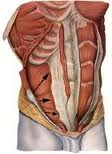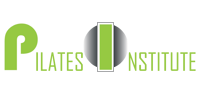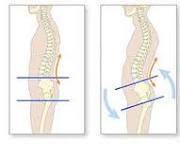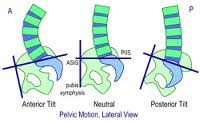The importance of a neutral spine/pelvis
At Pilates Institute, postural positioning is a primary focus since we believe that education in a “neutral spine/pelvis” is critical. We consistently provide exercise instructions to promote an “ideal alignment.”
Take a look at the following illustration:
On the left is the natural, resting position of the spine/pelvis also known as the “S Curve”. On the right, we see that extension of the spine results in anterior tilt of the pelvis and compresses the discs posteriorly (back side), resulting in an arched back position.
Positioning the spine in an anterior/posterior pelvic tilt position, causes increased compression on one aspect of the disc; however, by positioning the spine in a neutral position, compression is equalized, decreasing back discomfort, while promoting a strong, and healthier, posture!
In the left illustration, we see an anterior tilt, meaning that the lumbar spine arches and the pubic symphysis drops below the ASIS (front hip bones)..
In the right illustration, we see a posterior tilt, meaning the lumbar spine flattens out and the pubic symphysis raises above the ASIS (front hip bones).
Lastly, in the central illustration, we see a neutral spine/pelvis resulting in a natural curve in the lumbar spine where the pubic symphysis and the ASIS become level to one another.
At Pilates Institute, we encourage our clients to think of the pelvis as a triangle… all 3 points of the triangle should be on the same plane.
Neutral spine/pelvis is ideal and should be maintained throughout abdominal strengthening, promoting transverse abdominal strengthening; however, there are some Pilates exercises that move the spine in and out of neutral, such as articulation, where movement of the spine occurs.
Replacing the “Old School” with the “New School”
The “old school” of thought focused on “posterior pelvic tilt position”. This school of thought was based on the belief that the rectus abdominis (known as the 6 pack muscle) was the most important muscle to strengthen and would thus provide the best support and stability for the spine.
Contrary to this previous school of thought, research has proven the importance of the internal abdominals; transversus abdominals & obliques. Internal abdominal muscles provide control and stabilization for the spine, promoting good postures!
 You can see in this illustration that the rectus will provide flexion (forward bending) movement, as the striations (muscle striping) are all vertical. You also see that the transversus abdominals & obliques provide control as the striations are pulling from different directions.
You can see in this illustration that the rectus will provide flexion (forward bending) movement, as the striations (muscle striping) are all vertical. You also see that the transversus abdominals & obliques provide control as the striations are pulling from different directions.
When the transversus abdominals contract, we also facilitate the contraction of a posterior (back) muscle called the multifidus, and the contraction of the pelvic floor as it lifts upwards. These muscles work together providing a corset of stability. Promoting a neutral spinal position, helps promote these internal stabilizing muscles to recruit more efficiently!!
Putting this altogether, Pilates Institute holds to the school of thought that Transversus Abdominals are to be primary, and that a neutral pelvis promotes this facilitation, and that the Rectus Abdominis is to be secondary, thus avoiding the Posterior Tilt that promotes the rectus as a primary muscle.
For further reading, this page has an excellent illustration and discussion of the abdominal muscles.
The Right Breathing Pattern
Along with correct body positioning, breathing is another important aspect of our program. Pilates Institute conveys to its clients the importance of “breathing diaphragmatically with lateral focus.” This may seem confusing, but don’t worry, it’s much easier to do than it sounds!
Preparation Step: Stand up straight!
Elongation through the cervical spine and lateral breathing broadens the shoulders and elevates the pelvic floor, enhancing eccentric control of the superficial abdominals, allowing better blood flow through the abdominal aorta & vena cava. Poor posture changes the efficiency of your breathing, so better posture, results in more oxygen to your brain and into your muscles!
Step 1: Inhale through the nose
With each inhale, air is warmed as it enters the lungs and the focus is to allow the ribs to expand laterally (out both sides). The front rib cage remains engaged, flat and down. If the TA muscles remain slightly contracted, the ribs will remain engaged and down flat. Abdominals will be ready to intensify their contraction as you exhale.
Step 2: Exhale through a relaxed open mouth
With each exhale, relax your accessory breathing muscles. You want the feeling that you could fog a mirror, “HAAAing” the air out. The TA’s work in opposition of the diaphragm, which means when the diaphragm contracts (coiling down) the air is brought into the lungs. The TA’s contract, but not as strong as they can while exhaling. When we exhale, the diaphragm relaxes and the TA’s contract even stronger, pulling the ribs down into their engaged position, while helping to expel carbon dioxide.
For further reading, this page shows an excellent illustration of the diaphragm/ribs and the movement that takes place during the breathing cycle.


